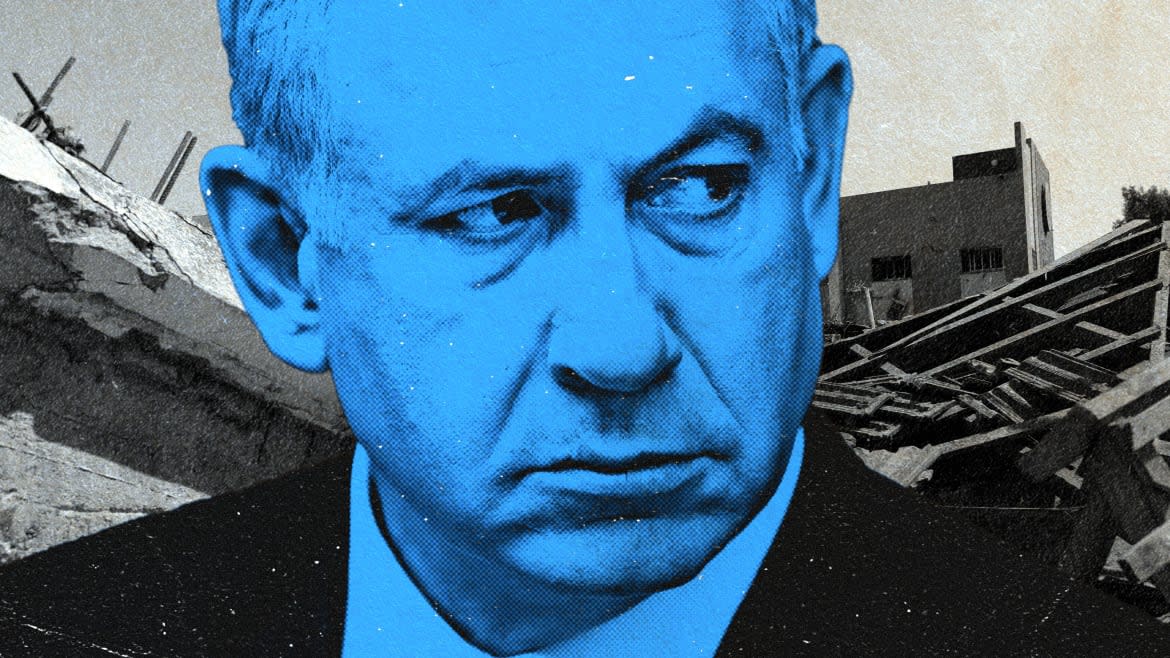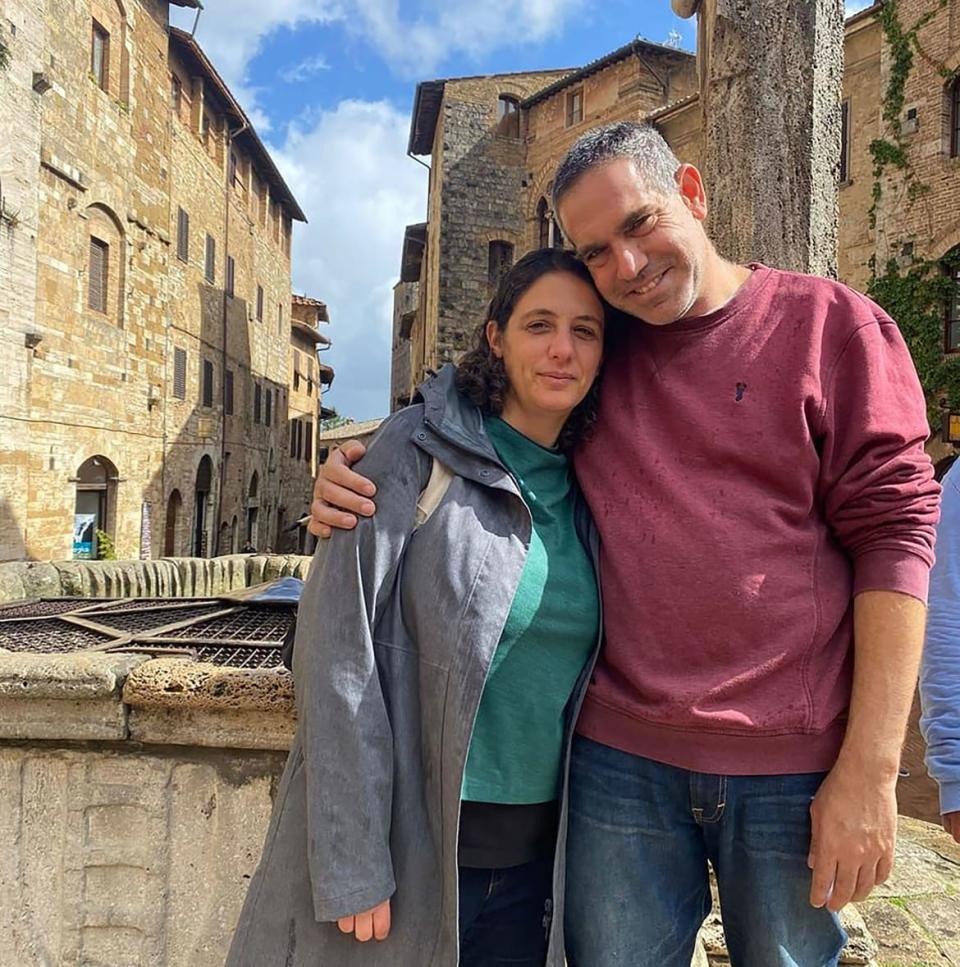Worst Failure in Israeli History: Netanyahu Abandoned the Very Heart of Israel

Over the last few days, many videos have become symbolic of the disaster that has befallen Israel. Two of them draw special attention. In the first, the viewer is blinded by a striking orange: Shiri Bibas and her two ginger sons, wrapped in a blanket, are videoed while being kidnapped into Gaza. The second shows an elderly woman, also wrapped in a blanket, wary, surrounded by a group of euphoric young Palestinians driving a golf cart of the sort usually utilized by old kibbutzniks.
“That’s my grandmother! Kidnapped into the Gaza Strip with no one there to stop it,” wrote her granddaughter, Adva Adar, the day after. “Her name is Yaffa Adar, she’s 85 years old! My grandmother, who built this kibbutz with her own two hands, who believed in Zionism, who loved this country that had forsaken her to be snatched away. Probably stowed away somewhere, suffering from terrible pain, with no medication, no food and no water, dying of fear, alone.”
Bibas and Adar are members of Kibbutz Nir Oz, one of the settlements located on the border of the Gaza Strip in an area called “the Gaza Envelope.” The true magnitude of the disaster in these small, old settlements is not yet widely known. What is clear, even now, is the total devastation. Hundreds of kibbutz members, along with their children, were murdered in their homes, among the paths and on the lawns; many were killed while trying to prevent the terrorists from going door-to-door in their murder spree. When they couldn’t be stopped, the terrorists butchered and dismembered adults, children and babies, and burned down houses with the residents still inside. Dozens of people from these settlements were taken away, their fate still unknown.
The feeling of devastation stems not only from the terrible losses but from the sheer magnitude of failure, perhaps the worst in Israeli history: the kibbutz members waited for the IDF for hours, and the IDF didn’t come. The Kibbutz Movement, which on Thursday had its flag lowered to half-mast, released a statement a few hours after the attack: “More than 10 hours have elapsed, and our many friends in the kibbutzim are struggling alone with bloodthirsty terrorists. More than 10 hours of heroism and helplessness. More than 10 hours that children, toddlers and the elderly are abandoned to their fate. We demand from the Israeli government and the Israeli Defense Forces to snap out of their shock, go on the attack and liberate the kibbutzim, moshavim and towns of the South!
“The Kibbutz Movement is grieving its sons and daughters, men, women and children who were murdered in cold blood in their own homes. Words cannot express the pain, horror and shock we feel at this loss of life. Our heart is torn and weeping.”
The Nightmare Scenario Staring Israel in the Face
A few days after the attack, I read a Facebook post by Bar Heffetz, the agricultural manager of the groves at Kibbutz Nirim where they grow avocados and lychees, among other things. It was addressed to Benjamin Netanyahu.
“Hello, Mr. Prime Minister,” he wrote. “I think that over the last four days, I earned the right to give you some advice on what you should do next.
“Leave managing the war to the General Staff. Give up, for one day, on dropping pompous posts and tweets. Take a military helicopter and go by the following route: start in Eilat, with my daughter and her friends, who are now burying their friends. From there, continue to Isrotel Yam Suf. Put off thy shoes, and go to each of the families from Nir Oz. Hear the stories of the mother who was left alone, of the grandfather whose entire family was murdered, of the old guard whose entire life’s work just went up in flames. Ask for forgiveness.”
Nirim is one of settlements initially named “11 points in the Negev:” 11 kibbutzim and moshavim that were established over a single night after Yom Kippur 1946, on legally purchased land, to bolster Jewish presence in the south of the British Mandate of Palestine.
To start with, the Zionist movement was diverse in activity and ideology. It encompassed socialists, liberals, rich philanthropists and farmers. Of these, the founders of the kibbutzim—as exemplified in the 11 points operation—were the ones to physically draw on the British Mandate of Palestine’s ground the outline of the future northern, eastern and southern borders of Israel. The kibbutzim are, in fact, the edges of Israel’s map.
Secondly, Europe had forbidden Jews for centuries from toiling the land, and so they had to become bankers and moneylenders—a state of affairs that served to stoke antisemitism. Zionism had sought to revolutionize the Jewish self-image, and the kibbutznik was the face of this revolution: a farmer, rooted firmly in the soil of the homeland, no longer a person making a living from “business in the air” (a Yiddish idiom describing various kinds of speculative monkey business) and subject to the national whims of a non-Jewish country of residence. This ethos of rootedness has given rise to such traits as practical wisdom, agricultural and industrial entrepreneurship and military creativity, which led many kibbutz members to become soldiers and commanders in the special op units. This is especially glaring in view of the army’s recent failure.
In addition to the revolution of the body, the kibbutz also symbolized a revolution in Jewish society. While Jewish communities in Europe were scattered, the kibbutz glued together its members and communities: they lived as a collective, sharing funds, living space and ideology.
At the time of the founding of the original kibbutzim, about 80,000 Muslim civilians were living in neighboring areas in the west, mostly in the city of Gaza. After the 1948 war, about 200,000 Palestinian war refugees flooded into the Gaza Strip. The area became one giant refugee camp.
On the other side of the border, additional kibbutzim and moshavim were founded during the 1950s, now collectively called “the Gaza Envelope Settlements.” They are situated inside Israel’s internationally recognized border, and most of their population lean center-left politically. They belong to the Kibbutz Movement, sons of the very secular pioneers who built Israel, and in Israeli culture represent the nemesis of the right-wing Likud camp, now personified by Netanhayu.
“Explain how you abandoned them for a decade because you preferred to consolidate the voter base in Judea and Samaria at their expense,” wrote Heffetz. “That you preferred to fund a terrorist organization; and that anytime that there was a real international willingness to reach an agreement, you rejected it because you preferred to drive a wedge between Gaza and the West Bank. Promise that you’ll do everything, everything in your power, to bring back their kidnapped relatives alive.

Ben Haffetz and his girlfriend Tal
“Go back to the helicopter and fly to the Dead Sea, where the evacuees from the charnel house in Be’eri are. Ask for their forgiveness for calling them traitors and shirkers, not to mention the filthy talk spewing out of the mugs of your lackeys and attack dogs. From there, fly on to Rahat. Ask for forgiveness from the families of the Bedouin who have fallen, and from those who spent hours under fire, evacuating the survivors of the Nova music festival.
“And then you can continue to my dad. My hero dad, who was with you and without you in Lebanon, Saudi Arabia, Egypt, Jordan and Syria, who caught a bullet while conquering the Hermon on the Syrian front. My father, who, at the age of 72, had to wait for hours with a handgun for the army to arrive, with his three grandchildren shut behind him in the safe room, and terrorists roaming the village paths.
“After you do all this, do a press conference. A real one. The sort where you answer questions. Ask for everyone’s forgiveness. And then, board a plane and get out of here. We will drop the trial, the commission of inquiry. Just don’t come back.”
On Friday night, Kibbutz Nirim celebrated the anniversary of the ‘11 Points’ establishment. “A little after 6 a.m. we woke up to the sound of an alarm siren,” Heffetz, who is now moving between Tel Aviv and Nirim, told The Daily Beast. “We ran to the safe room, which usually serves as my 15-year-old teenage daughter’s room. Alarms are part of our daily routine, but this time they were different. Another siren and another one, more and more, for more than 15 minutes. Around 7 o’clock, people started posting in the parent WhatsApp groups that this was something big. A little after 7, we began hearing gunfire. Very shortly after that, we heard shouts in Arabic.
“In such a case, the local emergency squad is called to respond immediately and is supposed to protect the kibbutz for 20 minutes, until the army gets there. Under no circumstances is it supposed to hold for more than 20 minutes. We were sure that the army was coming, but sometime after 8 o’clock, we received a notice from the local security team that they had no idea what was going on. And then we realized: something very, very unusual was happening.
“To cope with the fear, we turned ourselves into an operations room. I was on WhatsApp, my sister on Twitter, and my partner on the news websites. This is how we started to realize that the neighboring settlements are in a similar situation. My 72-year-old father, a veteran of Sayeret Matkal, pulled out the handgun that used to belong to his father. My father used to be an amazing fighter, and when he did this—my sister and I looked at each other and breathed a sigh of relief. He told us to lock ourselves in the safe room and sat down in the living room, armed.

Bar Haffetz in a lychee grove
“Fortunately, three members of the emergency squad managed to delay the terrorists somewhat from entering the houses. At 1.40 p.m., after hours of waiting, the first soldiers arrived and linked with the three emergency squad members. Their first step was to clear the way to three more squad members, who were locked in their safe rooms with their families. Together, they led the battle for the kibbutz. Towards the evening, they moved hundreds of kibbutz members to public buildings and secured them. A little later, because it was crowded, some of the members were moved to the ‘children’s houses.’”
Massacre Survivor: I Hid in Shower as Hamas Slaughtered My Boyfriend
During the Gulf War, Kibbutz Nirim decided to abolish communal child-rearing. Since then, its “children’s houses”—which used to be the main home of kids on the kibbutz who lived and learned communally—have served only as kindergartens and school classrooms. In the era of communal child-rearing, “children’s houses” used to be the center of the world for kibbutz children like me. Heffetz and I belong to one of the last generations to be raised communally.
Even though the kibbutzim have been largely privatized and their current residents are no longer the pioneers that their grandparents were, they are still a family, in the deepest, most instinctive sense of the word. The kibbutzim are a tribe, even when they do not know each other personally. One kibbutznik sees any harm done to another kibbutznik as if it was done to them. The terror surrounding this event is like someone breaching a safe in a communal bank of memories, images and sounds.
In 1980, a terrorist squad infiltrated Misgav Am on Israel’s northern border, took over a “children’s house,” and held the toddlers hostage. This became a key event in the nightmares of us communal housing children and was seared into the memory of many Israelis—a memory that is now triggered again by the sights of children and toddlers from the kibbutzim who were kidnapped or murdered after hiding for hours in the safe rooms. Heffetz, however, is more practical. He doesn’t view the removal of some of the besieged kibbutz members into the children’s houses as symbolic. “They’re just secure buildings,” he says.
Neighboring kibbutzim have suffered immense losses. In Nirim, about five members were killed and five or six more were kidnapped. “Nirim benefited from a combination of an emergency squad that operated correctly and of very anxious people, who went into the safe rooms immediately—and didn’t leave them,” says Heffetz.
What does he think happened in the hours he spent waiting for the IDF? “We need to go further and understand the IDF’s security conception for the Gazan border,” Heffetz says. “The settlements on the Northern border look to the north and see an army, Hezbollah’s army. When we look west, to the Gazan border, there is not a single Hamas soldier to be seen for miles. The army and the government told themselves: we’ll move the army outposts backward, to avoid conflict on the border, and equip the fence with the most sophisticated technology we have. And so, there were no outposts on the border with flesh-and-blood soldiers surveying the area.”
But the disastrous results of this oversight went on for hours after Hamas breached the border, while aircraft could be sent from the neighboring army airfields to protect the fallen fence. What does Heffetz think will happen now? “Israel has no choice but to eradicate Hamas. It must demand the unconditional return of the kidnapped women and children and allow Hamas leaders to be exiled to Qatar only upon the return of the kidnapped soldiers. And then it will have to convene the Saudis, the Egyptians and Mahmoud Abbas, and achieve the thing nobody ever wanted to work for regarding Gaza: an agreement.”
Heffetz’s prediction fits his own character: practical, proactive and collected. But the restoration and rehabilitation of this community will take years, and this recent disaster will always remain a defining event.
Get the Daily Beast's biggest scoops and scandals delivered right to your inbox. Sign up now.
Stay informed and gain unlimited access to the Daily Beast's unmatched reporting. Subscribe now.

 Yahoo News
Yahoo News 
